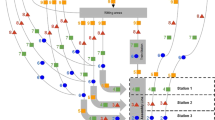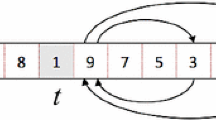Abstract
This paper presents an operations planning scheme based on mathematical programming models (specifically, Mixed-Integer Linear Programming (MILP) models) integrated into a web-enabled Advanced Planning and Scheduling System (APS), developed for and implemented in an engine assembler that supplies the car industry. One objective of this paper is to provide empirical insights into some operations planning characteristics in the automotive industry. The other main objective is to show MILP models and their use to create plans that enable the coordination of different planning levels (mid-term and short-term) and planning domains (procurement, production and distribution). The APS fulfills the requirements of an engine assembler in the automotive sector (namely lean-type constraints and objectives). The system is based on two MILP models, which have been purposely developed together along with their relations. The models presented herein provide a solution that considers supply chain objectives and constraints, and are integrated by means of data and constraints which have proven sufficient to fulfill users’ and stakeholders’ requirements. This case study presents the models’ most relevant aspects and their implementation.








Similar content being viewed by others
References
Bautista J, Companys R, Corominas A (1996) Heuristics and exact algorithms for solving the Monden problem. Eur J Oper Res 88(1):101–113
Begnaud J, Benjaafar S, Miller LA (2009) The multi-level lot sizing problem with flexible production sequences. IIE Trans 41(8):702–715
Bilgen B, Günther HO (2009) Integrated production and distribution planning in the fast moving consumer goods industry: a block planning application. OR Spectr 32(4):927–955
Boysen N, Fliedner M, Scholl A (2009) Level scheduling for batched JIT supply. Flex Serv Manuf J 21(1–2):31–50
Bozarth CC, Warsing DP, Flynn BB, Flynn EJ (2009) The impact of supply chain complexity on manufacturing plant performance. J Oper Manag 27(1):78–93
Cardos Carbonera M, Garcia-Sabater JP (2006) Designing a consumer products retail chain inventory replenishment policy with the consideration of transportation costs. Int J Prod Econ 104(2):525–535
Caridi M, Sianesi A (1999) Trends in planning and control systems: APS—ERP integration. In: Mertins K, Krause O, Schallock B (eds) Global production management. Kluwer, Dordrecht
Chen IJ (2001) Planning for ERP systems: analysis and future trend. Bus Process Manag J 7(5):374–386
Chern CC, Hsieh JS (2007) A heuristic algorithm for master planning that satisfies multiple objectives. Comput Oper Res 34(11):3491–3513
Choi TY, Hong Y (2002) Unveiling the structure of supply networks: case studies in Honda, Acura, and DaimlerChrysler. J Oper Manage 20(5):469–493
Chung SH, Snyder CA (2000) ERP adoption: a technological evolution approach. Int J Agile Manage Syst 2(1):24–32
David F, Pierreval H, Caux C (2006) Advanced planning and scheduling systems in aluminium conversion industry. Int J Comput Integr Manuf 19(7):705–715
Drexl A, Fleischmann B, Günther HO, Stadtler H, Tempelmeier H (1994) Konzeptionelle Grundlagen kapazi tätsorientierter PPS-Systeme. Zeitschrift für betriebswirtschaftliche Forschung 46:1022–1045
Dudek G (2004) Collaborative planning in supply chains. A negotiation-based approach. Springer, Berlin, p 2004
Fleischmann B, Meyr H (2003) Planning hierarchy, modeling and advanced planning systems. Handb Oper Res Manage Sci 11:455–523
Garcia-Sabater JP, Vidal P (2008) El problema de la programación del lote económico del ELSP: Una revisión de la literatura. X Congreso de Ingeniería de Organización 1:1–8
Garcia-Sabater JP, Maheut J, Marin-Garcia JA (in press) A new formulation technique to model materials and operations planning: the generic materials and operations planning (GMOP) problem. Eur J Ind Eng
Günther HO, Meyr H (2009) Supply chain planning and advanced planning systems. OR Spectr 31(1):1–3
Günther HO, Seiler T (2009) Operative transportation planning in consumer goods supply chains. Flex Serv Manuf J 21(1–2):51–74
Hahn CK, Duplaga EA, Hartley JL (2000) Supply-chain synchronization: lessons from Hyundai motor company. Interfaces 30(4):32–45
Ho JC, Chang YL (2001) An integrated MRP and JIT framework. Comput Ind Eng 41(2):173–185
Hüttmeir A, de Treville S, van Ackere A, Monnier L, Prenninger J (2009) Trading off between heijunka and just-in-sequence. Int J Prod Econ 118(2):501–507
Kannegiesser M, Gunther HO (2011) An integrated optimization model for managing the global value chain of a chemical commodities manufacturer. J Oper Res Soc 62(4):711–721
Lang JC (2009) Production and inventory management with substitutions. Springer, Berlin
Lee HL (2002) Aligning supply chain strategies with product uncertainties. Calif Manage Rev 44(3):105–119
Lloret J, Garcia-Sabater JP, Marin-Garcia JA (2009) Cooperative supply chain re-scheduling: the case of an engine supply chain. In: Springer B (ed) Lecture notes in computer science, vol 5738/2009, pp 376–383
Maheut J, Garcia-Sabater JP, Mula F (2012) A supply chain operations lot-sizing and scheduling model with alternative operations. In: Sethi SP et al (ed) Industrial engineering: innovative networks. Springer London
Meyr H (2004) Supply chain planning in the German automotive industry. OR Spectr 26(4):447–470
Meyr H, Wagner M, Rohde J (2005) Structure of advanced planning systems. In: Staedtler H, Kilger C (eds) Supply chain management and advanced planning: concepts, models, software and case studies, 3rd edn. Springer, Berlin, pp 109–115
Monden Y (1981) Production smoothing. Industrial engineering, pp 42–51
Monden Y (1994) Toyota production system. An integrate approach to just in time. Chapman & Hall, London
Mula J, Peidro D, Diaz-Madroñero M, Vicens E (2010) Mathematical programming models for supply chain production and transport planning. Eur J Oper Res 204(3):366–390
Ozdamar L, Yazgac T (1999) A hierarchical planning approach for a production-distribution system. Int J Prod Res 37(16):3759–3772
Parush A, Hod A, Shtub A (2007) Impact of visualization type and contextual factors on performance with enterprise resource planning systems. Comput Ind Eng 52(1):133–142
Piper CJ, Vachon S (2001) Accounting for productivity losses in aggregate planning. Int J Prod Res 39(17):4001–4012
Puig-Bernabeu X, Maheut J, Garcia-Sabater JP, Lario FC (2010) Algorithm for planning the supply of product with FTL strategy in lean environment: an industrial case. ICOVACS 2010 Valencia—international conference on value chain sustainability, pp 174–182
Quadt D, Kuhn H (2008) Capacitated lot-sizing with extensions: a review. 4OR Q J Oper Res 6(1):61–83
Rashid MA, Hossain L, Patrick J (2002) Enterprise resource planning solutions & management. In: Nah FF-H (ed) Enterprise resource planning solutions & management. IRM Press, USA
Riezebos J, Klingenberg W, Hicks C (2009) Lean production and information technology: connection or contradiction? Comput Ind 60(4):237–247
Sillekens T, Koberstein A, Suhl L (2010) Aggregate production planning in the automotive industry with special consideration of workforce flexibility. Int J Prod Res iFirst:1–24
Simpson NC, Erenguc S (2001) Modeling the order picking function in supply chain systems: formulation, experimentation, and insights. IIE Trans 33(2):119
Stadtler H (2005) Supply chain management and advanced planning—basics, overview and challenges. Eur J Oper Res 163(3):575–588
Stadtler H, Kilger C (2002) Supply chain management and advanced planning: concepts, models, software and case studies. Springer, Berlin
Sugimori Y, Kusunoki K, Cho F, Uchikawa S (1977) Toyota production system and Kanban system materialization of just-in-time and respect-for-human system. Int J Prod Res 15(6):553–564
Wang RC, Liang TF (2004) Application of fuzzy multi-objective linear programming to aggregate production planning. Comput Ind Eng 46(1):17–41
Wang S, Sarker BR (2005) An assembly-type supply chain system controlled by kanbans under a just-in-time delivery policy. Eur J Oper Res 162(1):153–172
Yokoyama M (2008) Flow-shop scheduling with setup and assembly operations. Eur J Oper Res 187(3):1184–1195
Acknowledgments
The work described in this paper has been partially supported by the Ministerio de Ciencia e Innovación del Gobierno de España within the Program de “Proyectos de Investigación Fundamental No Orientada through the project “CORSARI MAGIC DPI2010-18243″ and by the Universitat Politècnica de València, through the Project PAID-05-2010-2741. Julien Maheut holds a Val I + D grant funded by the Generalitad Valenciana (Regional Valencian Government, Spain) (Ref. ACIF/2010). The authors wish to thank three anonymous reviewers for their comments which have greatly improved the paper. They also wish to thank the people at the factory and at the IT consultancy firm for their continuous support and encouragement.
Author information
Authors and Affiliations
Corresponding author
Rights and permissions
About this article
Cite this article
Garcia-Sabater, J.P., Maheut, J. & Garcia-Sabater, J.J. A two-stage sequential planning scheme for integrated operations planning and scheduling system using MILP: the case of an engine assembler. Flex Serv Manuf J 24, 171–209 (2012). https://doi.org/10.1007/s10696-011-9126-z
Published:
Issue Date:
DOI: https://doi.org/10.1007/s10696-011-9126-z




